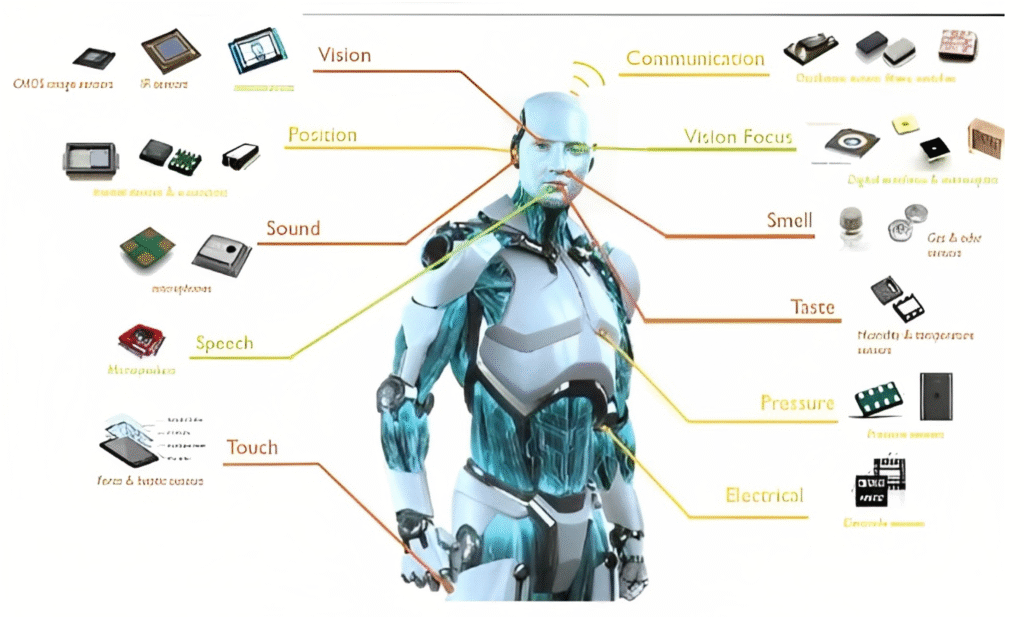
Communication systems in humanoid robots enable them to exchange information with users, other robots, and external systems. These systems are crucial for remote control, real-time data sharing, coordination, and human-robot interaction. Below is an overview of key communication systems used in humanoid robots, their features, and applications:
1. Wi-Fi (Wireless LAN)
- Description: A widely used wireless technology for high-speed data exchange over local networks.
- Features:
- High bandwidth for transmitting large amounts of data (e.g., video, sensor data).
- Range: Typically up to 100 meters indoors.
- Compatible with most devices and networks.
- Applications: Remote monitoring, real-time video streaming, software updates.
- Examples:
- ESP8266 or ESP32 Wi-Fi Modules.
- Wi-Fi-enabled single-board computers like Raspberry Pi.
2. Bluetooth
- Description: Short-range wireless communication for data exchange between devices.
- Features:
- Low power consumption.
- Range: Typically 10-30 meters.
- Suitable for pairing with mobile devices.
- Applications: Wearable robotics, personal humanoids, simple control systems.
- Examples:
3. Zigbee
- Description: A low-power, low-bandwidth wireless communication protocol for mesh networks.
- Features:
- Range: 10-100 meters, extendable with mesh networking.
- Ideal for distributed systems and low-data-rate tasks.
- Energy-efficient and robust in noisy environments.
- Applications: Swarm robotics, sensor networks, home automation robots.
- Examples:
4. Radio Frequency (RF) Communication
- Description: Long-range communication using RF modules in the unlicensed spectrum.
- Features:
- Range: From 100 meters to several kilometers (depending on power and frequency).
- Simple implementation for remote control and telemetry.
- Low data rate compared to Wi-Fi.
- Applications: Remote control of humanoids, telemetry, and long-distance coordination.
- Examples:
- nRF24L01+ Modules.
- LoRa Modules for ultra-long-range communication.
5. Cellular Networks (4G/5G)
- Description: Mobile network communication for internet-based data exchange.
- Features:
- High-speed, long-range connectivity.
- Supports real-time applications like video streaming and cloud processing.
- Requires a SIM card and data plan.
- Applications: Autonomous robots, telepresence, outdoor navigation.
- Examples:
6. Infrared (IR) Communication
- Description: Line-of-sight communication using infrared light.
- Features:
- Short range (up to 10 meters).
- Low bandwidth, suitable for simple tasks.
- Requires clear line-of-sight between transmitter and receiver.
- Applications: Remote control, basic signaling, object detection.
- Examples:
7. Ethernet
- Description: Wired communication for reliable and high-speed data exchange.
- Features:
- High bandwidth and low latency.
- Stable and interference-free communication.
- Requires physical cables, limiting mobility.
- Applications: Humanoids in research labs, industrial robots, and stationary setups.
- Examples:
8. CAN (Controller Area Network)
- Description: A robust communication protocol for microcontroller-based systems.
- Features:
- Real-time and deterministic communication.
- Resistant to electrical noise and interference.
- Widely used in distributed control systems.
- Applications: Multi-joint humanoid robots, actuator control, automotive robots.
- Examples:
9. UART/Serial Communication
- Description: A basic communication protocol for point-to-point data transfer.
- Features:
- Low complexity and easy to implement.
- Limited to short-range wired communication.
- Used for debugging and interfacing with peripherals.
- Applications: Sensor integration, actuator control, robot initialization.
- Examples:
10. ROS (Robot Operating System) Communication Framework
- Description: A middleware framework for managing communication between robot components.
- Features:
- Publish-subscribe messaging architecture.
- Interoperability across different hardware and software.
- Supports distributed communication.
- Applications: Advanced humanoid robots, multi-robot systems, research projects.
- Examples:
- ROS Topics for inter-node communication.
- ROS2 with DDS (Data Distribution Service) for real-time communication.
11. LoRa (Long Range)
- Description: A low-power, long-range wireless communication protocol.
- Features:
- Range: Several kilometers in open areas.
- Low data rate, suitable for telemetry and control.
- Ideal for remote or outdoor environments.
- Applications: Environmental monitoring, swarm coordination, remote humanoids.
- Examples:
- SX1276 LoRa Modules.
- Dragino LoRa Shield for Arduino.
12. MQTT (Message Queuing Telemetry Transport)
- Description: A lightweight messaging protocol for IoT and robotics.
- Features:
- Low bandwidth and power requirements.
- Publish-subscribe model for distributed systems.
- Suitable for cloud-based or internet-connected robots.
- Applications: Remote monitoring, multi-robot communication, cloud-based operations.
- Examples:
- MQTT Brokers (e.g., Mosquitto).
- Integration with IoT platforms like AWS IoT.
13. Audio Communication
- Description: Enabling robots to interact with humans or other robots using voice or sound.
- Features:
- Real-time bidirectional audio.
- Can be paired with speech recognition and synthesis systems.
- Suitable for interactive robots.
- Applications: Human-robot interaction, telepresence, team coordination.
- Examples:
- Microphone arrays and speakers.
- Audio codecs for streaming.
Key Factors to Consider When Choosing a Communication System
- Range: Ensure the communication range matches the robot’s operational environment.
- Bandwidth: High bandwidth is necessary for tasks like video streaming and multi-sensor data sharing.
- Latency: Low-latency systems are critical for real-time control and interactions.
- Power Consumption: For battery-powered robots, prioritize energy-efficient communication protocols.
- Interference: Use robust systems in environments with high electromagnetic noise.
- Scalability: Choose systems that support multi-robot coordination or future upgrades.
Applications of Communication Systems in Humanoid Robots
- Remote Control: Allowing operators to control humanoid robots in real-time.
- Sensor Data Sharing: Transmitting vision, audio, or environmental data to processors or cloud systems.
- Human-Robot Interaction: Facilitating speech, gestures, or multimedia interactions.
- Multi-Robot Coordination: Synchronizing tasks and movements among multiple robots.
- Telemetry: Monitoring the robot’s status, such as battery life, temperature, or position.
The choice of communication system depends on the robot’s specific requirements, operational environment, and intended applications.
